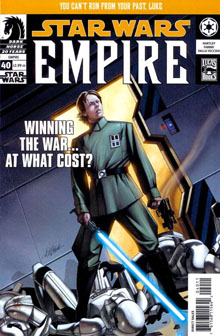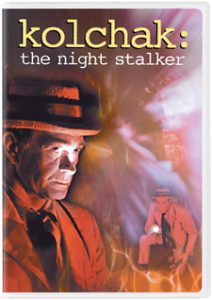“Empire” wraps up its run (well, sort of – the storylines will continue in “Rebellion”) with a pair of five-issue epics that take advantage of established threads.
Following a couple of flawed but interesting one-shots (Issues 13 and 23), Jeremy Barlow (writing under the pseudonym Thomas Andrews) bursts onto the “Star Wars” writing scene with the flashback-peppered “In the Shadows of Their Fathers” (29-30, 32-34). I didn’t care for Haden Blackman’s “The Battle of Jabiim” (“Republic” 55-58) due to Anakin abandoning the Jabiimi rebels on orders from his superiors, as it seemed out of character. However, if we accept that the story did happen, it makes sense that Jabiim would be one of Anakin/Vader’s many regrets. Barlow picks up on this idea:
“Jabiim. A lifetime ago he lost a piece of himself on this insignificant world. It’s one of the few places to which he vowed never to return.”
I don’t like that the Jabiimi rebels turn on Luke Skywalker simply because he is Anakin’s son. (At least the leader, Nolan, understands that Luke is his own man.) But overall, Barlow nicely shows how the decisions of Anakin and Nolan’s father during the Clone Wars have repercussions 20 years later. In the case of Nolan’s father, it’s his belief in isolationism – that the Jabiimi rebels should turn their backs even on potential friends for fear of being back-stabbed again. But Nolan rebels against that line of thinking and invites the Rebel Alliance in. As he tells his second-in-command:
“We’ve maintained our independence, but at what cost? So we keep fighting and eventually we regain control. Then what? We declare Jabiim a sovereign system in a hostile galaxy?”
“In the Shadows of Their Fathers” also brings back Alliance supply runner Nera Dantels (Biggs’ girlfriend), who fits in smoothly with our favorite heroes. It’s nice to see Leia joined by another woman on the team rather than being the token female. And it initiates threads that will be continued in the next five-parter: The Empire grabs an Alliance statistician, Jorin Sol, who knows the location of the fleet, and hauls off a bunch of Jabiimi citizens for slave labor.

That five-parter, “The Wrong Side of the War” (36-40) is another meticulously plotted and illustrated classic from writer Randy Stradley (as Welles Hartley) and the art team of Davide Fabbri (pencils and colors, with Neziti Domenico) and Christian Dalla Vecchia (inks). The most notable part of the Alliance’s undercover mission to spring Jorin Sol from the Imperial outpost on Kalist VI is that Luke runs into Imperial Lieutenant Janek Sunber, a.k.a. his childhood friend Tank whom we knew from this exchange in “A New Hope”:
Uncle Owen: “Look, it’s only one more season.”
Luke: “Yeah, that’s what you said last year when Biggs and Tank left.”
I won’t lie – it irks me to no end that Sunber doesn’t take this opportunity to defect and join the Alliance. Despite serving on a base that has a slave labor camp below it, despite seeing a fellow officer pull a slave out of the mess line in order to rape her, and despite his admiration of Luke, Sunber sticks with his Imperial ideals of “bringing order (and) discipline” and tells his old Tatooine friend: “You’re on the wrong side of this war.” Even in the foul belly of the beast, Imperial propaganda is hard to overcome, apparently.

Still, perhaps it’s better to have a morally conflicted villain than a purely evil villain, and at any rate, Sunber is only one aspect of this rich story that also includes Deena Shan and the clone Able among the undercover Rebels. It also tacks on a mystery when Jorin Sol’s Imperial interrogator says of his rescue by the Rebels: “Everything’s going according to plan.”
From the category of nitpicks, the Red/Rogue Squadron confusion continues: In “In the Shadows of Their Fathers,” Wedge says, “You’re always telling me you’re the best pilot in Rogue Squadron, Hobbie – prove it!” But in “The Wrong Side of the War,” they’re back to Red Squadron again. (The 2013 “Star Wars” series, set further along the timeline, chronicles the moment when Wedge comes up with the Rogue moniker.)
In another continuity note, the first issue of “The Wrong Side of the War” features Imperial clones who aren’t from the Jango batch: Perhaps these are Spaarti clones, as introduced in Timothy Zahn’s books.
This batch of issues also includes two one-shots. In “The Price of Power” (31), writer Scott Allie toys with reader expectations by making a velociraptor-looking species into the protagonist weapon manufacturers who find Vader’s boot on their necks. The president smartly retires rather than continue with the political games that will probably get him killed by one side or the other.
“Model Officer” (35) is notable for being the debut “Star Wars” work from John Jackson Miller, who would later earn a substantial fanbase for the “Knights of the Old Republic” comics, not to mention the outstanding Western-style novel “Kenobi.” (With the possible exception of Michael Stackpole, Miller is the elite multiple-media “Star Wars” writer.) Here, Vader tricks a deceitful Alderaanian officer into blowing up a base of Alderaan refugees.
Stories where Vader gets vindictive and vengeful with his underlings seem slightly off to me, as Vader’s command style is easy to figure out in the films: If you carry out his orders, he respects you (see Piett); if you screw up, he kills you (see Ozzel and Needa). Also, it seems like the Empire’s style in the wake of blowing up Alderaan would be to gather up all its Alderaani servicemen (surely they keep records of their officers’ home worlds?) and send them to slave labor camps or execute them. Then again, Luke and company are able to pose as Imperial fuel technicians and hang out on Kalist VI for days, so perhaps Imperial record-keeping is quite shoddy.
Overall, “Empire’s” 40 issues illustrate the totalitarian government of the Empire and how it affects Alliance and Imperial personnel alike, not to mention small-time freedom fighters like the Jabiimi rebels. While the films tell of the major clashes at Yavin, Hoth and Endor, these comic stories make a strong case that the war is actually won in places like Ralltiir, Jabiim and Kalist VI – not to mention interstellar space, as is the case with Biggs’ and Hobbie’s mutiny on the Rand Ecliptic.

